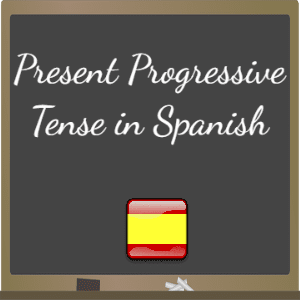The present progressive tense in Spanish, similar to its use in English, describes an event that continues to take place in the present, e.g., “Yo estoy hablando” (I am speaking). We form the present progressive tense in Spanish by adding the auxiliary verb “estar” to the present participle, also known as the gerund. We form the gerund by attaching “-ando” to the stem of “-ar” ending verbs and “-iendo” to the stem of “-er” and “-ir” ending verbs.
| “-ar” verbs | subject pronoun + “estar” in present tense + (verb stem+ ando) |
| “-er” verbs | subject pronoun + “estar” in present tense + (verb stem+ iendo) |
| “-ir” verbs | subject pronoun + “estar” in present tense + (verb stem+ iendo) |
Let us look at some examples:
| -ar ending e.g., hablar | -er ending e.g., comer | -ir ending e.g., vivir | ||
| yo | estoy | hablando | comiendo | viviendo |
| tú | estás | |||
| él/ella/usted | está | |||
| nosotros/-as | estamos | |||
| vosotros/-as | estáis | |||
| ellos/ellas/ustedes | están |
Unlike in English, it is possible to use the present simple tense to describe something happening continuously at the moment to convey the same meaning as the present progressive tense. For example, “¿Qué haces ahora?” and “¿Qué estás haciendo ahora?” can both mean “What are you doing now?” Similarly, “Hablo con mi amigo” and “Estoy hablando con mi amigo” both mean “I am talking to my friend.”
Irregular Gerunds
We have mentioned that a gerund can be easily constructed by attaching “-ando” to an “-ar” ending verb and “-iendo” to an “-er” or “-ir” ending verb. Nevertheless, there are a few irregular verbs that require some practice:
The gerund of the verb “ir” (to go), which is a very common verb in Spanish, is “yendo,” e.g., “Yo estoy yendo al aeropuerto” (I am going to the airport). To say “I’m coming” in Spanish, you could use “Estoy yendo” or “Ya voy” because in Spanish we use the verb “ir” based on the point of reference of the speaker rather than that of the destination.
In verbs ending in “-er” or “-ir,” if the stem (the remaining part of the verb after removing the “-er” or “-ir” ending) ends in a vowel, “-iendo” becomes “-yendo.” For example, the gerund of “leer” (to read) is “leyendo,” the gerund of “atraer” (to attract) is “atrayendo,” the gerund of “destruir” (to destroy) is “destruyendo,” and that of “huir” (to run away) is “huyendo.”
Many verbs ending in “-ir” that change stem in third-person forms of the present tense conjugation from “e” to “i” or from “o” to “u” maintain the same stem change in the gerund form. For example, “decir” (to say) becomes “diciendo,” “pedir” (to ask for) becomes “pidiendo,” “dormir” becomes “durmiendo,” and “morir” (to die) becomes “muriendo.”
In the verbs ending in “-er” or “-ir,” if the stem ends in “-ll” or “-ñ,” “-iendo” becomes “-endo.” There are few verbs in this group, most of which are not very common. For example, “bullir” (to boil) becomes “bullendo,” “mullir” (to fluff) becomes “mullendo,” and “teñir” (to dye) becomes “tiñendo,” where the latter changes the first “e” to “i” as an exception to the rule.
Quiz: Present Progressive Tense in Spanish
Other lessons in Level III:











